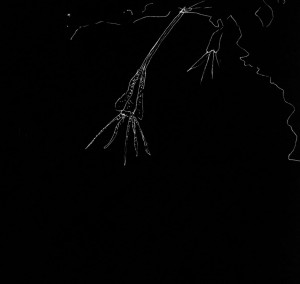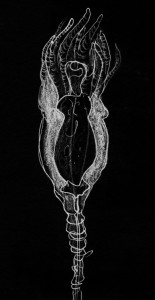Hydrozoa are a class of invertebrates within the phylum Cnidaria. Hydrozoa are carnivorous, feeding mostly on small crustaceans, fish eggs and larva. Cnidaria are characterized by a life cycle that includes the presence of planula larva, defined as “a free-swimming cylindrical larva bearing numerous cilia” by The Encyclopedia Britannica. In an ideal life cycle, the planula swims until it encounters a suitable substrate, which it anchors to and begins metamorphosis into the polyp stage (if present). Hydrozoas live as polyps, medusae, and species that alternate between the two (Towle 1989). The polyp may be solitary or form colonies of thousands via asexual reproduction, known as budding (Hammond, 2009). In colonial hydroids these individual polyps are differentiated for various functions, such as feeding, capturing prey, and creating medusoids (Waggoner and Smith, 1995). When medusoids are produced they swim free from the colony and resume sexual reproduction (Hammond, 2009).
Hydrozoans vary greatly in size and
can be found all over the world (Hammond, 2009). They can live in almost every aquatic habitat, including deep sea trenches, lakes, ponds, caves, and even the spaces between sand grains (Hammond, 2009). Many live on other organisms such as fishes, tunicates, polychaetes, mollusks, sponges, algae, and crustaceans (Hammond, 2009). These symbiotic relationships may be parasitic, but they can also involve mutualism or commensalism (Boero and Bouillon 2004). Studies indicate that bacteria in the environment factors heavily into where the planula larva lands and grows. (Leitz, 1994). Animal development depends on cell communication by various kinds of signals, and in some hydroids it has been shown that the planula undergoes metamorphosis in response to chemical signals provided by bacteria, instead of the larva’s own somatic processes (Leitz, 1994).
Hydrozoas have remarkable morpho-genetic abilities (Tardent,1963). Vital functions are distributed amongst a very small number of cell types which have a high standard of physiological autonomy and adaptability, allowing them to undergo great structural and functional transformation (Tardent,1963). However, these cells still undergo a normal amount of senescence, which is compensated for by a permanent growing “back stock” of indifferent (meaning non-specific for any one purpose) replacement cells (Tardent,1963). Pierre Tardent finds in his study of the regeneration of hydrozoa that within “a single polyp or colony the quantitative pattern of the morphogenetic or regenerative potentials is inversely proportional not only to the degree of tissue differentiation (Needham, 1952), but also to the progress of physiological ageing.” He explains that regenerations occurs in response to accidental mutilation, but is also an integral part of their life cycle, growth and sexual/asexual reproduction. It is used as a method to rejuvenate terminal organs that are often short lived, as well as replacing parts of the colonial system that might be destroyed by environmental factors.
Overfishing, eutrophication, climate change, translocation and habitat medication seems to be resulting in increased jellyfish production, to the detriment of other marine organisms (Richarson, 2009). Evidence suggests that a pelagic ecosystem “can change rapidly from one that is dominated by fish (that keep jellyfish in check through competition or predation) to a less desirable gelatinous state, with lasting ecological, economic, and social consequences” (Richarson, 2009).
 I think there is a poetic connection between Medusae and the mythological figure of Medusa. Vernacularly similar, they are also both monstrous, mysterious, tentacular and ancient beings. To further the connection it is told within certain versions of the slaying of medusa that her/its blood turned into the coral reefs—the habitat of many hydrozoa (Haraway, 2014).
I think there is a poetic connection between Medusae and the mythological figure of Medusa. Vernacularly similar, they are also both monstrous, mysterious, tentacular and ancient beings. To further the connection it is told within certain versions of the slaying of medusa that her/its blood turned into the coral reefs—the habitat of many hydrozoa (Haraway, 2014).
Now, through ocean acidification, we are destroying or greatly altering the coral reefs. Could this be seen as a modern retelling of Medusa, once again slaying what sprang forth from its blood? And maybe this destruction is once again a transformation. Now Medusa changes to the medusae, the jellyfish that may be thriving as a result of human activity. The hydrozoa/medusae/medusa figure could be a wonderful metaphor and source of inspiration for this metamorphosis, transformation, and thriving within destruction. Throughout history humans within power seem to kill what they see as unimportant and undesirable. But they never quite succeed, because the monstrous know how to transform. And the tentacular ones live on, waiting for their chance to emerge.
Sources
- Waggoner, Ben M. Gtdrizia, and Smith, David. Hydrozoa: More on Morphology, (6/13/1994 – 11/22/1994). Retrieved November 20, 2015 from: http://www.ucmp.berkeley.edu/cnidaria/hydrozoamm.html
- Richardson, Anthony, Bakun, Andrew, Hays, Graeme C., Gibbons, Mark J., Trends in Ecology and Evolution, Volume 24, Issue 6, pages 312-322 (June 2009)
- New World Encyclopedia, (2014, March 29). Retrieved 02:04, November 25, 2015 from http://www.newworldencyclopedia.org/p/index.php?title=Hydrozoa&oldid=979747.
- Hammond, G. 2009. “Hydrozoa” (On-line), Animal Diversity Web. Accessed November 24, 2015 at http://animaldiversity.org/accounts/Hydrozoa/
- Wilhelm Roux’ Archiv für Entwicklungsmechanik der Organismen, 1972, Volume 169, Number 4, Page 271
- Leitz, Thomas, Kenneth Morand, and Mann, Matthias.Developmental Biology Volume 163, Issue 2, , Pages 440–446 (June 1994)
- Harraway, Donna. SF: String Figures, Multispecies Muddles, Staying with the Trouble. University of Alberta, Alberta. (March 24, 2014). Retrieved December 2, 2015 from: https://www.youtube.com/watch?v=Z1uTVnhIHS8



